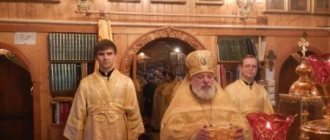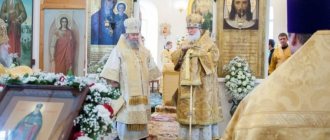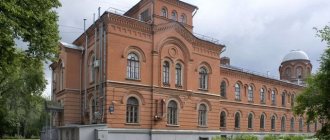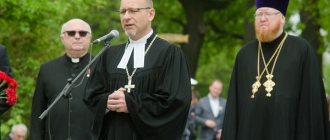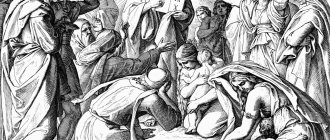House temple - how is it different from an ordinary temple?
In fact, the meaning of what a house church is lies in its very name - it is a temple that is located in a house. Moreover, a house, both in the broad sense (any building, structure), and in the narrow sense - a personal mansion or private mansions.
Why are house churches built (or should it be more correct to say: house churches)? They are arranged in cases where there is a desire or need to have a temple, but there is no possibility or need to erect it in the form of a separate building.
As in the case of chapels, a house church is created to help a person, at a certain moment or in a certain place, break out of the usual bustle and connect thought with God. But unlike the chapel, the church has an altar, and therefore the Sacrament of Liturgy and Communion can be performed in it. Therefore, one of the meanings of house churches is to organize them where there are people who, for one reason or another, do not have the opportunity to get to neighboring churches: for example, in hospitals or military units.
See also: chapel: what it is and how it differs from a temple.
An unusual example of a house church. House church in the name of the icon of the Mother of God “Seeking the Lost” at Plekhanov University. From the outside it looks like a full-fledged temple, but in fact it is only part of a house, which is even larger, and that is why the temple is considered a brownie. Photo: patriarchia.ru
Links[edit]
- ^ a b
David, Stephen.
"Ten Reasons for Small Churches". NTRF
. Archived from the original on December 28, 2016. Retrieved February 25, 2014. - Simson, Wolfgang (2005), Homes that Change the World
, Authentic Media, pp. 79–101. - Philip Carrington, The Early Christian Church: Volume 1, The First Christian Century
, Cambridge University Press, UK, 2011, pp. 41-42 - "Bible Passage: 1 Corinthians 16:19 - English Standard Version". Bible portal
. - George Thomas Kurian, Mark A. Lamport, Encyclopedia of Christianity in the United States, Volume 5
, Rowman and Littlefield, USA, 2016, p. 1142. - Floyd W. Filson (June 1939). "The Significance of the Early House Churches". Journal of Biblical Literature
.
58
(2): 105–112. DOI: 10.2307/3259855. JSTOR 3259855. - Assistant
. Archived from the original on February 20, 2006. - Fenn, John (26 August 2016). "Patrick or Constantine". International Church Without Walls
. - Erwin Fahlbusch, Geoffrey William Bromiley, Encyclopedia of Christianity, Volume 4
, Wm. B. Eerdmans Publishing, USA, 2005, p. 163 - Yves Mamou, Yves Mamou: “Les persécutions de chrétiens ont lieu en majorité dans des pays musulmans”, lefigaro.fr, France, March 20, 2022.
- Wesley Rahn, In Xi We Trust - Is China Suppressing Christianity? , dw.com, Germany, January 19, 2022
- Allan Heaton Anderson, Introduction to Pentecostalism: Global Charismatic Christianity
, Cambridge University Press, UK, 2013, p. 104 - Jump up
↑ Brian Stiller,
Evangelicals Around the World: A Global Handbook for the 21st Century
, Thomas Nelson, USA, 2015, p. 328 - Mark A. Lamport, Encyclopedia of Christianity in the Global South, Volume 2
, Rowman and Littlefield, USA, 2022, p. 364 - Citation error: The reference given by Dillon2001 was called but was not defined (see the help page).
- Buang, Saeda; Chu, Phyllis Gim-Lian (9 May 2014). Muslim Education in the 21st Century: Asian Perspectives
. Rutledge. paragraph 75. ISBN 978-1-317-81500-6. Subsequently, a new China was founded on the basis of communist ideology, that is, atheism. Under this ideology, religion was viewed as a "distorted" worldview, and people believed that religion would definitely disappear in the end along with the development of human society. The Chinese Communist Party carried out a series of anti-religious campaigns from the early 1950s to the late 1970s. As a result, for nearly 30 years from the early 1950s to the late 1970s, mosques (as well as churches and Chinese temples) were closed and imams were forced into forced “re-education.” - Grim, Brian J.; Finke, Roger (2010). The Cost of Freedom Denied: Religious Persecution and Conflict in the Twenty-First Century
. Cambridge University Press. ISBN 9781139492416. In an effort to completely destroy religion, churches were closed; temples, churches and mosques were destroyed; artifacts are broken; sacred texts were burned; and even possession of a religious artifact or sacred text was considered a criminal offense. Atheism has long been the official doctrine of the Chinese Communist Party, but this new form of militant atheism has done its best to eradicate religion completely. - Jump up
↑ Bays, Daniel (2012).
A New History of Christianity in China
. Malden, MA: Wiley-Blackwell. pp. 182, 190–195. - Henning, Geoffrey. "The Growing Homes and Churches Movement". Ministry today
. - “House Church vs. Organic Expression—Beyond Evangelical | Frank Viola's Blog".
- Dale, Felicity. "Starting a simple church can be easy". Just a church
. Retrieved February 26, 2014. - Viola, Frank. "Why the Organic Church Isn't Really a Movement". Christianity Today
. - A Parish Comes to Life by
Ernie Southcott, London: Mowbray, 1961. - Roberts, Mark D. "Leading the Church in Difficult Financial Times". Patheos
. - House2House Magazine Website, » What do we mean by Simple Church Archived 2007-09-27 at the Wayback Machine
- Dale, T. and Dale, F. (2000) Simply Church
. Caris Books, ISBN 0-9718040-1-X - What we do: Plant simple churches. Archived September 27, 2007, at the Wayback Machine.
- Cole, N. (2005) The Organic Church: Growing Faith Where Life Is
. John Wiley & Sons, ISBN 0-7879-8129-X - Larry Kreider, "House Churches and Micro-Churches [ permanent dead link
]" (accessed September 29, 2006) - Arnold, Laurie (January 19, 2000). "Displaced Pastor Believes the Grass is Greener Outside". Christian times. Archived from the original on October 22, 2006. Retrieved May 1, 2022 .CS1 maint: bot: original URL status unknown (link)
- See David Garrison, “The Church Planting Movement” (Southern Baptist Convention of the International Board of Missionaries, 2004); and Rad Zdero, The Global House Church Movement (William Carey Library Publishing, 2004, ISBN 0-87808-342-1).
- "Missionary's Friend". Archived from the original on March 3, 2016. Retrieved January 2, 2022.
- Toman, Roger, House Church Basics Pt. 3: Missional Church
, retrieved September 29, 2006 - In a recent version, the letter "D" is designated as "Divine Connection", and the Word of God and prayer are seen as the two main means of maintaining this connection with God. Thus, the DNA metaphor is expanded to include four overarching values instead of three.
- Neil Cole and Paul Kaak, Organic Greenhouses for Church Planters:
First Story
Resources .
Long Beach, 2004) pp. 1-6. Also published in Organic Church
by Neil Cole. - What do we mean by simple church. Archived September 27, 2007, at the Wayback Machine (accessed September 29, 2006).
- MetroSoul website, "What We Do: Planting Grassroots Churches." Archived September 27, 2007, at the Wayback Machine" (accessed September 29, 2006)
- Cole, N. Organic Church
- Chandler and Aryanpur, Michael Alison and Ariana (4 June 2006). "Going to Church While Staying Home: Clergy-Free Living Room Services Are a Growing Trend". Washington Post
. Retrieved September 30, 2006. - Laidlaw, Stuart. "Religion, but not the church". Toronto Star. Retrieved September 30, 2006.
- Van Biema and Healy, David and Rita. “There is no department like home.” Time . Retrieved September 30, 2006.
- Barna, G. (2005). Revolution
. Tyndale House. ISBN 1-4143-1016-1. - Barna, G. (2005). Revolution
. Tyndale House. paragraph 49. ISBN 1-4143-1016-1. - J. Lee Grady, Dangerous Proposal Barna, archived March 2, 2012 at the Wayback Machine" (accessed September 30, 2006)
Further reading[edit]
[1]
- Atkerson, Steve (2005). House Church: Simple, Strategic, Biblical
. USA: NTRF. ISBN 0-9729082-1-8 .CS1 maint: location (link) - Banks, Robert. Paul's Idea of Community: The Early House Churches in Their Historical Setting (1994). Peabody: Hendriksen, ISBN 978-0853642510.
- Banks, Robert and Julia, The House Church: Regrouping God's People for Community and Mission (1998). Peabody: Hendriksen ISBN 978-1565631793.
- DeVries, David (2010). Six-Word Lessons to Discover the Missionary Life: 100 Six-Word Lessons to Align Every Believer with the Mission of Jesus
. Bellevue: International leader on the brink. ISBN 978-1-933750-26-2. - Fenn, John (2010). Return of the First Church
. Dog Ear Publishing. ISBN 978-1608442201. - McHaffie, Barbara J. (2006). Her Story: Women in the Christian Tradition
(2nd ed.). Minneapolis: Augsburg Fortress. ISBN 0-8006-3826-3. - Osiek, C.; Margaret Y. McDonald (2006). A Woman's Place: House Churches in Early Christianity
. Minneapolis: Fortress Augsburg. ISBN 0-8006-3777-1. - Simson, Wolfgang (2001). Homes That Change the World: The Return of House Churches
. Authentic. ISBN 1-85078-356-X. - [2]
- Viola, Frank and George Barna (2008). Pagan Christianity?: Exploring the Roots of Our Church Practice
. Carol Stream: BarnaBooks. ISBN 978-1-4143-1485-3. A scholarly work based on the Bible and church history that reveals the origins of modern church practices such as the modern pastoral role, pulpits, church buildings, church attire, tithing, seminaries, etc. Shows that many of these practices have roots in a mixture of the New Testament with the Old Testament and Roman pagan customs. - Viola, Frank (2008). Rethinking the Church: Realizing the Dream of Organic Christianity
.
Colorado Springs: David K. Cook. ISBN 978-1-4347-6875-9. A constructive continuation of pagan Christianity
; explains the purpose of Christian fellowship, spontaneous church meetings (1 Cor. 14:26), and the priesthood of all believers (1 Pet. 2:9). Extensive bibliography of organic church literature. - Viola, Frank (2009). Finding the Organic Church: A Comprehensive Guide to Building and Sustaining Authentic Christian Communities
.
Colorado Springs: David K. Cook. ISBN 978-1434768667. A practical sequel to Reimagining Church
; explains biblical models for planting and nurturing organic church communities and how they can overcome the common challenges they will inevitably face. - Zdero, Rad (2004). Global House Church Movement
. Pasadena: William Carey Library Publishing. ISBN 978-0-87808-374-9. - Zdero, Rad (2007). NEXUS: The Worldwide House Church Movement Reader
. Pasadena: William Carey Library Publishing. ISBN 978-0-87808-342-8. - Bio, Ed Stetzer (25 May 2022). "Some Quick Thoughts on House Churches: The Good, the Bad, and Why You Should Be Open to Them". Christianity Today
. Exchange.
House churches: where they can be located
- In hospitals and clinics. Of course, there are full-fledged small churches on the territory of some hospitals. But where there is no possibility or purpose to erect a separate building, house temples are built. They are arranged primarily for patients and staff.
- In military units. For military personnel.
- In educational institutions. Now - mainly at theological academies. But not only. For example, there is a large house church at Moscow State University on Vozdvizhenka. House churches at institutes are an old tradition that carries the idea of spiritual education for students.
- In monasteries, house churches can be located in any auxiliary or service buildings. They, as a rule, play the role of “small” churches, in which services are held “on occasion” (for example, on the days of major Holidays or the memory of saints in whose honor the temple is consecrated).
- In private homes. They probably don’t do this now, but before the revolution, a very rich landowner could place a house church in one of his mansions.
- In government premises. For example, there is a house church in the building of the Accounts Chamber of the Russian Federation in Moscow.
Patriarchal service in the house Church of the Three Saints in Paris. Photo: patriarchia.ru
House churches: what are they?
If someone says that a house church is somehow “worse” than ordinary churches, then this is not true. All churches are equal, the Holy Liturgy is served in each.
Another thing is that, as a rule, house churches are small and less luxurious in architectural forms or decoration (although there are exceptions). But these are all human circumstances that in no way affect the depth of spiritual life or the essence of the Sacraments. Saints and early Christians sometimes took communion in ordinary caves.
See also[edit]
- Evangelical Christianity Portal
- Christianity portal
- Cafe church
- Church in a pub
- Church planting
- House Church (China)
- Local churches (affiliation)
- Missionary Church
- Pub-church
- Restorationism (Christian primitivism)
- Schuilkerk was a type of house church in the Netherlands during the 17th and 18th centuries.
- Two by Two - also known as Cooneyites
,
Christian Conventions
,
Meetings
,
Workers and Friends
,
The Way
or
The Truth
House churches in Moscow (photo)
Here, look, examples of house churches in Moscow. Photos are taken from the official websites of these churches, links in the signature.
The home church of the great martyr and healer Panteleimon at the Russian Scientific Center for Surgery named after. B.V. Petrovsky RAMS. It is located in this building:
and looks like this:
House church at the Accounts Chamber of the Russian Federation. Here's the building itself:
And here is the temple itself: (essentially: the only altar)
The home church of the Holy Martyr Tatiana at Moscow State University named after M.V. Lomonosov. An example of a house church, which in size and decoration is in no way inferior to large parish churches.
The home church of all Moscow Saints at the Moscow Compound of the Holy Trinity Sergius Lavra. It is also quite large: two altars.
And this is the mansion in which the temple is located. The house is called the Metropolitan Chambers. Before the revolution, this was the residence of Patriarch Tikhon.
House Church of the Prophet Elijah on Vorontsov Field. An example of a temple located in a very simple house:
But inside, thanks to the layout, it is quite large:
This is him too. You can’t even tell that this is a living cube:



